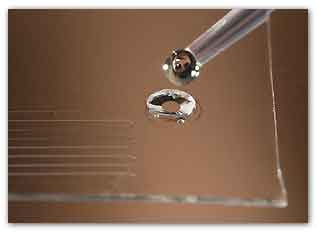News and Insights for
your best life. Online since 1998
- Home Health
- Breaking news
- In caso di...
- Per saperne di
più... - Medicina occidentale
- Medicine complementari
- Medicina cinese
e agopuntura - Omeopatia
- Fitoterapia

Brigham Young University chemist Adam Woolley and his students made a device that can detect markers of kidney disease and prostate cancer in a few minutes. All you have to do is drop a sample into a tiny tube and see how far it goes.

A device made at BYU screens for kidney disease, prostate cancer on the spot. The tiny tube is lined with DNA sequences that latch onto disease markers in urine. While healthy samples flow freely, a diseased sample gets clogged and stops short of the mark. Credit: Mark A. Philbrick, BYU
That's because the tube is lined with DNA sequences that will latch onto disease markers and nothing else.
Urine from someone with a clean bill of health would flow freely through the tube (the farther, the better). But even at ultra-low concentrations, the DNA grabs enough markers to slow the flow and signal the presence of disease.
"In a disease state, this particular marker is equal to about one billionth of a percent of the content of urine." Woolley said. "We can detect close to those levels. If we can get below that, it would give us better sensitivity for somebody at an early stage of the disease."
Grad students Debolina Chatterjee and Danielle Mansfield co-authored the study for the journal Analytical Methods using synthetic urine samples. The next step is to do human trials with this "lab on a chip."
The method holds several advantages over current tests for prostate cancer: No blood draws, instant results and potentially higher accuracy.
Men who get their blood screened for a prostate specific antigen are really only learning whether their prostate is enlarged, and sometimes cancer is the cause.
But the BYU device works only when there is an exact match to a disease marker that is 22 RNA bases long. Harmless material that closely resembles the disease marker doesn't sound a false alarm.
"The flow distance is about 20 to 40 millimeters longer if just one of those 22 letters is wrong," Woolley said.
Although the new study specifically looked at prostate cancer and kidney disease, this same method could be used to make a diagnostic tool for other diseases.
"In a urine sample there can be millions of different sequences of micro-RNA and what we need to do is find the ones related to a disease," Woolley said.
For more information
Analytical Methods
Microfluidic devices for label-free and non-instrumented quantitation of unamplified nucleic acids by flow distance measurement
The Brigham Young University
MDN
del Dott. Turetta
Quali sono i problemi o le disfunzioni che possono giovarsi di un intervento omeopatico d'urgenza e, di conseguenza, come dovrebbe essere un ideale armadietto medicinale omeopatico casalingo.- Home -
- Health -
- Depressione -
- Sexuality
- Environment -
- Food -
- Musica -
- Capirsi -
- Grafologia -
- Ridere
Copyright © 1998/2018 www.mybestlife.com tutti i diritti sono riservati eccetto quelli già di altri proprietari.
.In caso di
Pubblicità
Per saperne di più su
Pubblicità
Pubblicità
Pubblicità
Pubblicità


